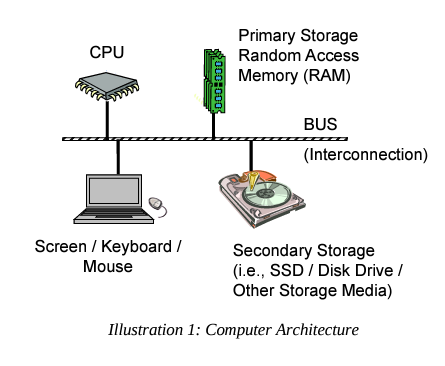- Computer Architecture is a "description of the structure of a computer system made from component parts." (Wikipedia, 2024)
- Computer Organization is the way in which the various components of a computer system are arranged to accomplish the architecture. (Part Wikipedia, part me)
- They actually define this as the computer architecture.
- According to Jorgensen "assembly language is a "low-level" language and provides the basic instructional interface to the computer processor".
- He incorrectly states that this is as close to the processor as you can get as a programmer.
- You can actually get closer with machine language.
- The basics of computer architecture
- The basics of assembly language
- No not really.
- If you look at history of architecture/implementation you will find a wide variety of designs and implementations.
- We will generalize, but you can almost always find something that breaks the generalization.
- Remember, this is engineering, not science.
- Engineering "the practice of using natural science, mathematics and the engineering design process to solve technical problems, increase efficiency and productivity and improve systems." (Wikipedia)
- For now, transistors are electronic switches.
- Later we will examine these in more detail.
- We will not consider quantum computers.
- These gates can perform logical or boolean operations.
- Typical gates include and, or, not
- We will examine gates more closely later as well.
- Some well know circuits include adders, registers, multiplexers, ...
- We will examine some of these circuits more closely later.
- The CPU or central processing unit.
- Primary storage or RAM (random access memory)
- Secondary storage or
- Hard drive
- USB Drive
- ...
-
 (From Jorgensen)
(From Jorgensen)
- I/O (input output) devices.
- All of these are connected by one or more busses (or data transfer system)
- Most machines are built according to the von Neumann architecture.
- Based on a paper by John von Neumann who worked on a draft report about the EDVAC (Electronic Discrete Variable Automatic Computer) computer system
- A predecessor to ENIAC
- At the University of Pennsylvania
- von Neumann architecture describes a stored program computer
- This is mostly what we call a computer today.
- von Neumann said that memory holds both program and data.
- An alternative, the Harvard Architecture says that you have different memory for program and data.
- This difference will not matter to us.
- Based on a paper by John von Neumann who worked on a draft report about the EDVAC (Electronic Discrete Variable Automatic Computer) computer system
- However there are other machines in production today.
- Parallel architectures come in several flavors.
- Flynn's Taxonomy
Data Instruction Single/Single SISD
Single/Multiple SIMD
Multiple/Single MISD
Multiple/Multiple MIMD
- SISD is what you think you use
- MIMD is probably what you use
- Multiprocessor (multi core) are one type.
- Your graphics card is probably SIMD
- MISD computers are somewhat rare.
- Mostly pipeline computers.
- Until the 70's instruction sets were designed with the programmer in mind.
- There were many instructions to do very complex operations.
- This was called CISC: Complex Instruction Set Computer
- The current intel family is an example of a CISC
- These machines became increasingly more expensive to
- design
- make run faster
- Studying programs it was found
- Most programs didn't use the entire instruction set.
- There were many instructions that were never or rarely used.
- Only expert assembly programmers could optimize better than a compiler
- And compilers have continued to improve
- So the RISC or reduced instruction set computer was designed.
- The ARM chip is RISC, but so is the intel chip.
- Most programs didn't use the entire instruction set.
- Observation that the number of transistors in an integrated circuit will double every two years.
- Gordon Moore, was a major player in the IC industry
- This observation occurred in 1965
- The prediction has mostly held.
- Many have declared it dead over the years.
- But some say it's not dead yet!
-
 (Max Roser, Hannan Ritchie)
(Max Roser, Hannan Ritchie)
- This is from Hennessy and Patterson
- As you increase speed, you increase the heat produced
- And eventually you can not run a processor any faster.